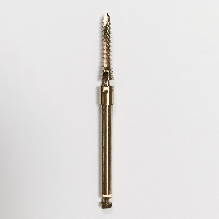
MISS® screw
Product description
MISS® Mini-Invasive System Screw
ISO 5832-3 standard titanium twist-off, self-drilling and self-tapping screw.
Blister with 5 traceability stickers.
The M.I.S.S® screw was developed in collaboration with Dr Michel Bénichou (St Roch Clinic, Montpellier), for minimally invasive foot surgery. This technique allows scarf osteotomies to be carried out with a minimal number of instruments (square punch, a three pin spanner slotted screwdriver and cutting guides).
Minimally invasive foot surgery gives the patient a more aesthetically pleasing result (scar reduced to 2 cm).
Dimensional characteristics
M.I.S.S screws have a head diameter of 2.6mm and a body diameter of 2mm and come in many lengths: 13mm, 15mm, 17mm, 19mm and 22mm. The screw and guides comes sterilized in a double blister pack with 5 traceability stickers.
Minimally invasive surgery on Hallux Valgus
1. Incision
Longitudinal, lower medial, two to three centimetres long, centred on the joint line and the cephalic extremity of the first metatarsal head.
2. Lateral arthrolysis
Position the metatarsophalangeal joint to achieve maximum plantar flexion.
Access the metatarsosesamoidal zone, section the metatarsosesamoidal lateral ligament with the bistoury, then place a bone separator between the sesamoid bones at the bottom and on the cephalic metatarsal crest, and section the phalangeal insertional band of the conjoined tendon.
3. Bone cleansing
The big toe is pushed into valgus so that the exostosis protrudes.
Minimal bone resection (1mm) is carried out with a saw.
The bare surface of the bone, continuous with the medial edge of the metatarsal diaphysis, allows the cutting guide to be correctly placed.
4. Placing of the cutting guide
Subcutaneous separation of the medial side and the proximal sole of the metatarsal diaphysis, and placing of the cutting guide.
The guide's proximal pointed end is placed under the diaphysis, and the guide's distal end is placed flush with the dorsal surface.
The guide is maintained in place with two fingers, one pressing through the skin on the proximal extremity, the other on the mark located at the distal extremity of the guide.
5. Metatarsal osteotomy
The metatarsal osteotomy through the cutting guide starts 5mm back from the joint surface.
The cut is made from the distal to the proximal on the medial cortex, through the plantar cortex and continues from proximal to distal on the lateral side.
The guide controls the cut in the sagittal plane, the angle given to the saw in the horizontal plane results in a corresponding lowering. The guide is then removed.
The transverse distal cut, on the dorsal cortex, is made under visual control, perpendicularly to the axis of the second metatarsal, or with a shortening effect.
6. Bone displacement
The osteotomy zone is cleared by osteotomy or bistoury, of the lateral side periosteal and capsular attachments limiting displacement.
The lower cephalic fragment is laterally displaced, by traction on the upper fragment and pressure on the lower fragment.
The two joint surfaces, the metatarsophalangeal and the metatarsosesamoidal, must be aligned.
7. Metatarsal osteosynthesis
With one hand, the osteotomy is stabilised by dorsal flexion and varus of the joint. With the other hand, the osteosynthesis is carried out using the motor unit.
Two dorsal plantar 17mm long twist-off M.I.S.S screws, slightly divergent and unicortical, fix the distal part of the upper fragment which is then resected by saw.
8. Varisation phalanx osteotomy
The varisation phalanx osteotomy is basal, incomplete medial closing wedge, short oblique, directed from medial to lateral, from proximal to distal, and slightly plantar dorsal.
It is carried out subcutaneously by saw. A varisation effect can be associated with a derotation.
With one hand, the osteotomy is stabilised. With the other hand, the osteosynthesis is carried out using the motor unit with one 17mm long twist-off M.I.S.S screw, unicortical, transversal and slightly oblique from distal to proximal and dorsal.
9. Shortening phalanx osteotomy
The shortening phalanx osteotomy, as described by H.Tobalina, is complete, long oblique, proximal to distal and dorsal to sole, starting against the joint dorsal surface, and ending at the sole surface of the distal diaphysis. The saw blade must remain in contact with the bone.
A shortening effect can be associated with a varisation.
The osteosynthesis is carried out using one or two dorsal plantar twist-off M.I.S.S screws. The boney dorsal "cap" is resected by visual control.
10. Closing
The medial capsular excess can be removed. Capsule closing is carried out without tension by two inverted points. The cutaneous excess can be resected. Cutaneous closing is carried out by absorbable continuous intradermal suture.
11. Post-operative follow-up
Immediate support. Wearing of shoes with variable volume.
ancillary equipment
14.33.25: square awl for MISS screw
14.31.12: screwdriver for MISS screw
To ensure traceability, the screws are individually packaged individually in double blister packs, the first containing the screw and a sterilisation indicator label; the second blister contains the first blister and five traceability stickers with the screw reference, description and batch number.
The packed screws are then sent to Synergy Health France (MIN des Arnavaux- 13014 MARSEILLE) for sterilisation by gamma radiation according to the ISO 11137-02, ISO 11737-1, ISO 11737-2, EN 552, EN 556 standards and dose mapping. After sterilisation, SYNERGY HEALTH returns the batch of sterilised screws with a certificate of sterilisation by gamma radiation.
The screws in the packaging are then labelled. The label includes the description, the reference, the production batch number, the method of sterilisation, the expiry date, the "single use" and "read instructions before use" symbols, the manufacturer's name and address and the CE 1014 markings.
The screws are packed in boxes identically labelled as above, stretch-wrapped and stored in closed cupboards, away from direct light. Storage conditions: no special conditions.


